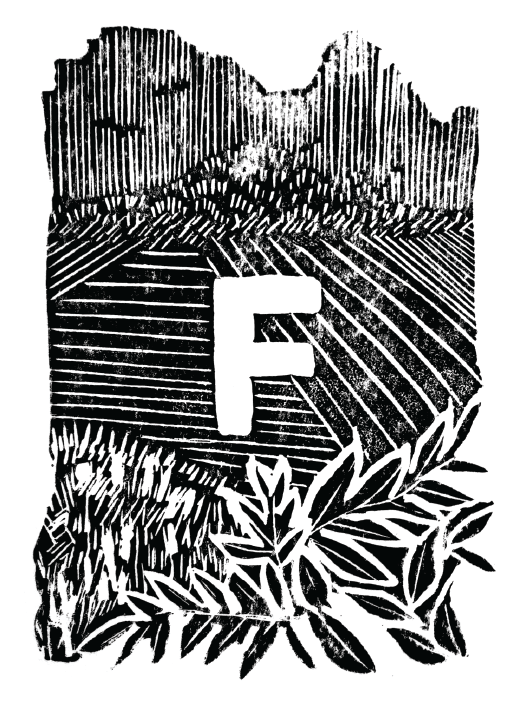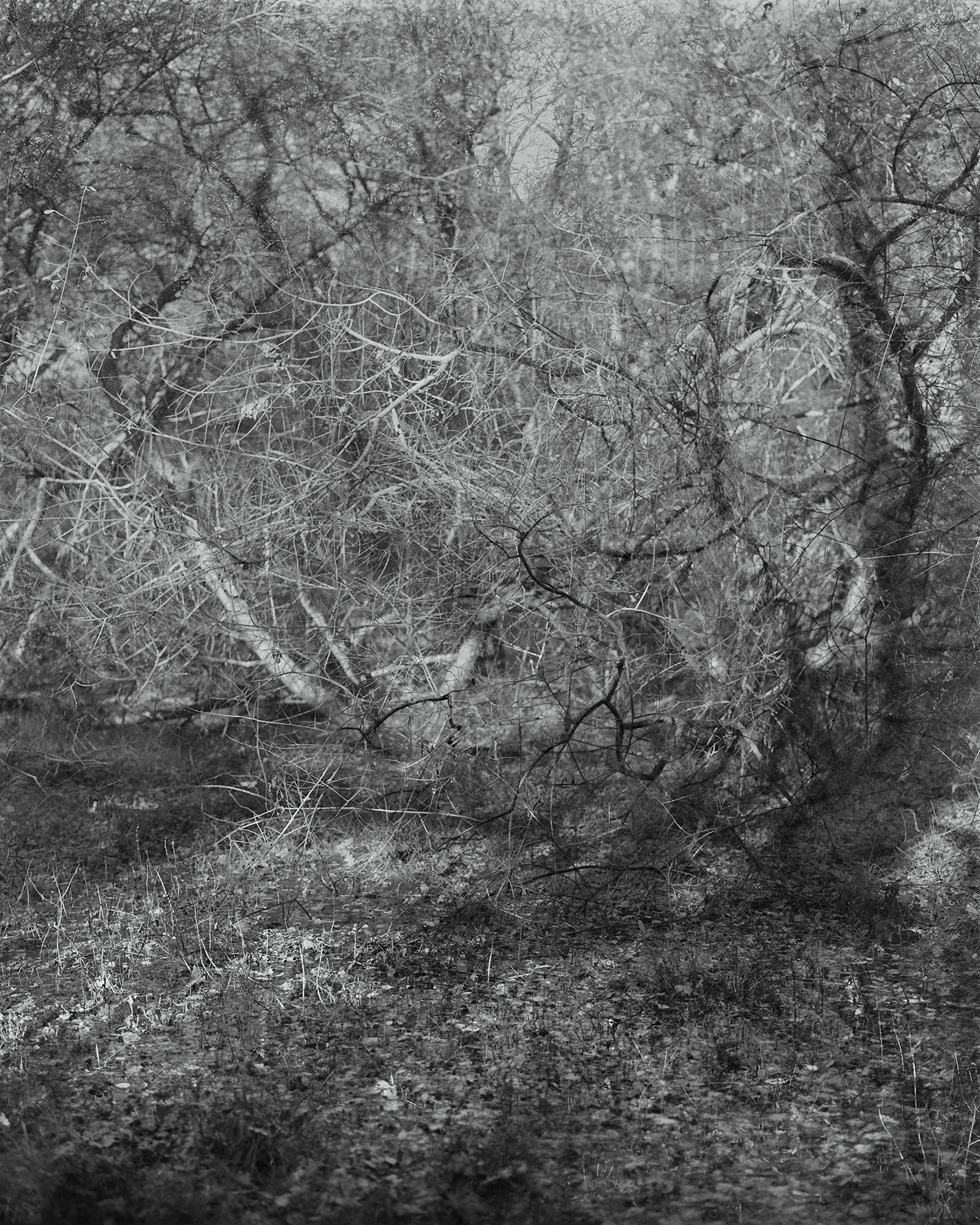Motus
Driven by impulse and poetic sensitivity, Jonty captures the overbearing rhythms of his South Wiltshire landscapes through an analogue Wista Field camera. His monochromatic abstractions disturb, calm, absorb; each saturated frame — composed and indefinite, assembled and fragmentary — dances with redolent forms and strange voids. Here, he shares his process and works.
Essay by Jonty.
Photograph: Jonty Sale, 'BLACKDOG' (2014)
We’ve been here in South Wiltshire, the 3 of us, for 13 years or so. We headed west from London, reaching a place which felt sufficiently rural whilst maintaining good transport links. The catalyst for leaving the capital was a 16-month sojourn on the Finistère coast, Brittany; we rented our London house, upped sticks, and developed a taste for the space and pace of the countryside.
‘Eschewing the pastoral tradition, the photographs are not meant to reassure, but rather to agitate and stimulate.’
It’s the impulse that made me pick up a camera in the first place — the act of noticing. It stems from setting words down when I was a teenager, trying to make form from an instance that caught my attention; if I notice a thing, I feel a responsibility to that noticing. When, in my 20s, I got around to picking up a camera, I found that it enabled this noticing to be made acutely and efficiently. Also, photography as a medium compliments the grain of equivocality that runs through me.
Photograph: Jonty Sale, 'SEMBLANCE #554'
The sort of photographic experience that interests me, at least in the landscape work, is not sudden and final and definitive. It is a corollary of my experience of the landscape, where I am aware of it going on all around me on a scale I am ignorant of, but going on nonetheless, in constant change. To be static in these environments and to consider the total visual stimulation is overwhelming; to move through them offers multitudinous perspectives, no single one of which can adequately describe the place.
Eschewing the pastoral tradition, the photographs are not meant to reassure, but rather to agitate and stimulate. This is what turns me on — this bewilderment, this uncertain state. And, as ever, certain places, during certain seasons, turn me on more, and I have the need to photograph them. Because the images lack the specifics of location, being not-recognisable places they are free to be an any where the viewer chooses, and as such they are free to exist in the imagination. If I succeed in making an image which resonates, there is always the hope that, in turn, it will turn others on.
Photograph: Jonty Sale, 'SEMBLANCE #996'
Photograph: Jonty Sale, 'SEMBLANCE #999'
If I review my work in chronological order, patterns and threads become discernible. My contact sheets are organised roughly thus, and exhibit annual cycles of interest and ideas arrived at, tried out, adopted, and discarded. These developments seem to be coterminous with the duration of my time in this area – that it is I who changes, as much as the landscape does. I find my interest and excitement lie increasingly in the apparent perplexity of growth and form, in the haphazardness of thickets, of briars and brambles and thorns.
There are places I visit over and again to photograph, year on year. Some exhaust my fascination, others persist, and some places just happen to be where I happen to be. I don’t doubt that with the way I work there’s a blend of luck and judgment to a good image. I am more of an emotional than an intellectual photographer, preferring to trust my inclinations, and whilst I carry ideas with my camera, they have to fit the purpose.
Photograph: Jonty Sale, 'SQUALLSMIRE #1' (2013)
These images are all multiple exposures, meaning that I build them up in layers on a single negative, fractioning the exposures. I work mainly on a Wista Field camera, so it’s fairly simple: a 5" x 4" negative is contained in a holder which slides onto the rear of the camera, beneath the ground glass upon which the image is composed. I process the film in my darkroom, then I make contact prints, laying the negative directly on photographic paper and exposing, for reference, and for the thrill or disappointment of seeing what I have made come to life.
Photograph: Jonty Sale, 'SQUALLSMIRE #2' (2014)
Photograph: Jonty Sale, 'SQUALLSMIRE #5'
Photograph: Jonty Sale, 'SQUALLSMIRE #6'
There are periods of intense concentration and contemplation when I work, and they are all out in the field. It is the closest I ever come to a state of bliss. This happens when alone, and I am aware that it is a rare state to experience, that it doesn't easily translate, and that it certainly doesn't guarantee good photography.
Thereafter, there is the regular rhythm of the things that have to be done to get to the next stage — rigmarole for sure, but rewarding. Music always occupies the darkroom when I do, all sorts and nothing in particular. There have been times when listening to certain music that I am impressed by its non-linearity, and I take note of that as a reminder to be wary of a too-standard approach to picture making.
I don't think you choose your process; I think that it fits in to the given parameters of your life, and then you tinker with it to suit. Process is adaptive, making the best of what is available.
‘If I notice a thing, I feel a responsibility to that noticing.’
I enjoy the analogue process because it has parameters: the cameras I use are simple, mechanical, powerless tools for capturing reflected light and, given my darkroom layout and dimensions, there are only certain outcomes possible. For 11 years, my darkroom has been an 8' x 13' uninsulated room with no damp-proofing in the local brewery, 4 miles from home. Because of the lack of insulation, I brought heaters, one of which I place beneath the large processing sink and, with adjustments as I go, this enables me to maintain the 20ºC required for standard printing. Because of the damp, I brought a dehumidifier which I run 24/7, collecting the clean condensate in a 25-litre tank, which I then use for processing film (an improvement on the brewery's water supply which is drawn from an aquifer and can contain particulate matter). So, it transpires that the limitations of the room can be turned to advantage, or at least incorporated.
I should add that we are currently in the process, that word again, of building a workshop/darkroom/garage outbuilding at the foot of the garden which has been designed with the work process implicitly in mind. I am trusting that after 11 years of managing a darkroom I had to fit into, I now understand what I need from a darkroom that is made to measure. I think my work process will change with the new building, primarily because I will have a space to lay out my mind and my pictures together, which to this point has not been possible. Let's see.
Photograph: Jonty Sale, 'SQUALLSMIRE #9'
I am unsure if there are unique opportunities for rural photographers; as far as subjects are concerned, subjects there have always been. It just takes a photographer who knows what they want. I suspect that the world of photography is as challenging as ever it was, whether it is practised in the country or the town. However, there are established galleries and region-wide art festivals throughout the south-west, and some metropolitan galleries are making the transition to rural locations, so exhibiting is possible on a more noticeable scale.
The greatest challenge — and this has been the same circumstance no matter where I am — is to find the time necessary to undertake a project, satisfy its creative demands, make it as well as I can, and finally produce a coherent and complete work. Still, I’d rather be daydreaming from a window that gave on to a field moved by wind, a woodland breeding birdsong, and a vast expanse of sky, to enjoy solitariness in those places, and be able to walk out in whatever weather and be in that weather.
Photograph: Jonty Sale, 'TERRACES #1' (2013)
Photograph: Jonty Sale, 'TERRACES #3' (2014)
Greatest extravagance: Neat liquor.
Favourite time of year: The here and now: the May blossom of the hedge is almost obscene in its profusion, green is a colour in the making, and cricket is returned to the radio. The rest of the year will come around again.
A book or film most enjoyed recently: The novel, The Overstory, by Richard Powers: grist to the mill.
Published on: 16 May 2019. Edited by Fields in Fields. All images courtesy of Jonty Sale. Current exhibition: 'west lands', Make Hauser & Wirth Somerset, 6 April – 1 June 2019. He lives and works in Wardour, Wiltshire. ▪ Visit jontysale.com











